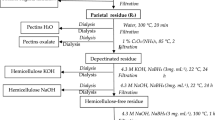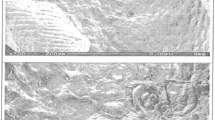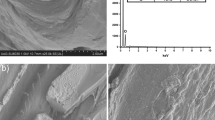Abstract
This study aims to remove zinc by using banana peel from an aqueous medium. The peel was a lignocellulosic adsorbent and characterized by FTIR spectra, SEM–EDS images, and elemental analysis. The effect of contact time, pH, and adsorbent dosage on the sequestration of zinc was observed. The sorption process of zinc was well described with the pseudo–second-order kinetic and Langmuir isotherm model. The rate-limiting step to the adsorption process was determined by applying the intra-particle diffusion model. The removal mechanism is that ion exchange, electrostatic interaction, complex formation, physical adsorption, and precipitation carried out in cooperation with the banana peel functional groups and zinc ion in many ways. FTIR analysis demonstrates that the surface carboxylic/hydroxyl functional groups of banana peel play a key role in the adsorption of zinc ions. The results showed that banana peel, a locally available fruit residual, is an efficient and eco-friendly adsorbent to reduce Zn2+. The usage of banana peel as an adsorbent for the sequestering of zinc from water ensures both the technical advantage and cost-effectiveness of the sustainable environmental management concept and zero waste strategy. Furthermore, the value-added products containing organic compounds and zinc can be used efficiently as a soil conditioner.






Similar content being viewed by others
Data Availability
The datasets used and/or analyzed during the current study are available from the corresponding author on reasonable request.
Abbreviations
- KF:
-
Freundlich constant (mg/g) (L/g)1/n
- 1/n:
-
Freundlich exponent
- KL:
-
Langmuir isotherm constant (L/mg)
- k1p:
-
Pseudo–first-order kinetic model constant (1/h)
- k2 :
-
Pseudo–second-order kinetic model constant (gmg−1 h−1)
- kp:
-
Intra-particle diffusion kinetic model constant (gmg−1 h−0.5)
- R2 :
-
Correlation coefficient
- MPSD:
-
Marquardt’s percent standard deviation
- ARE:
-
Average relative error
- NSD:
-
Normalized standard deviation
- P:
-
Number of parameters in isotherm
- N:
-
Number of experimental measurements
- Ce:
-
Equilibrium concentration (mg/L)
- C0 :
-
Initial concentration (mg/L)
- Ct:
-
Concentration at time t (mg/L)
- qe:
-
Amount of metal ion adsorbed at equilibrium (mg/g)
- E:
-
The mean adsorption energy (kJ/mol)
- qm:
-
Monolayer sorption capacity (mg/g)
- T:
-
Time (h)
- T:
-
Temperature (K)
- R:
-
Ideal gas constant (JK−1 mol−1)
- kd:
-
The distribution constant for Gibbs’ free energy
- V:
-
Volume of the solution (L)
- W:
-
Amount of adsorbent used (g
References
Ali, R. M., Hamad, H. A., Hussein, M. M., & Malash, G. F. (2016). Potential of using green adsorbent of heavy metal removal from aqueous solutions: Adsorption kinetics, isotherm, thermodynamic, mechanism and economic analysis. Ecological Engineering, 91, 317–332. https://doi.org/10.1016/j.ecoleng.2016.03.015
Anastopoulos, I., Omirou, M., Stephanou, C., Oulas, A., Vasiliades, M. A., Efstathiou, A. M., & Ioannides, I. M. (2019). Valorization of agricultural wastes could improve soil fertility and mitigate soil direct N2O emissions. Journal of Environmental Management, 250, 109389. https://doi.org/10.1016/j.jenvman.2019.109389
Baloo, L., Isa, M. H., Sapari, N. B., Jagaba, A. H., Wei, L. J., Yavari, S., et al. (2021). Adsorptive removal of methylene blue and acid orange 10 dyes from aqueous solutions using oil palm wastes-derived activated carbons. Alexandria Engineering Journal, 60(6), 5611–5629. https://doi.org/10.1016/j.aej.2021.04.044
Chwastowski, J., Bradło, D., & Żukowski, W. (2020). Adsorption of cadmium, manganese and lead ions from aqueous solutions using spent coffee grounds and biochar produced by its pyrolysis in the fluidized bed reactor. Materials, 13(12), 1–14. https://doi.org/10.3390/ma13122782
Çoruh, S., Geyikçi, F., Kiliç, E., & Çoruh, U. (2014). The use of NARX neural network for modeling of adsorption of zinc ions using activated almond shell as a potential biosorbent. Bioresource Technology, 151, 406–410. https://doi.org/10.1016/j.biortech.2013.10.019
Costa, H. P. de S., da Silva, M. G. C., & Vieira, M. G. A. (2021, April 1). Biosorption of aluminum ions from aqueous solutions using non-conventional low-cost materials: A review. Journal of Water Process Engineering. Elsevier Ltd. https://doi.org/10.1016/j.jwpe.2021.101925
Depci, T., Kul, A. R., & Önal, Y. (2012). Competitive adsorption of lead and zinc from aqueous solution on activated carbon prepared from Van apple pulp: Study in single- and multi-solute systems. Chemical Engineering Journal, 200–202, 224–236. https://doi.org/10.1016/j.cej.2012.06.077
Dimkpa, C. O., Andrews, J., Sanabria, J., Bindraban, P. S., Singh, U., Elmer, W. H., et al. (2020). Interactive effects of drought, organic fertilizer, and zinc oxide nanoscale and bulk particles on wheat performance and grain nutrient accumulation. Science of the Total Environment, 722, 137808. https://doi.org/10.1016/j.scitotenv.2020.137808
Dubinin, M. M., & Radushkevich, L. V. (1947). The equation of the characteristic curve of activated charcoal. Proceedings of the Academy of Sciences, Physical Chemistry Section, 55, 331–337.
Feizi, M., & Jalali, M. (2015). Removal of heavy metals from aqueous solutions using sunflower, potato, canola and walnut shell residues. Journal of the Taiwan Institute of Chemical Engineers, 54, 125–136. https://doi.org/10.1016/j.jtice.2015.03.027
Fernández-López, J. A., Angosto, J. M., Roca, M. J., & Doval Miñarro, M. (2019). Taguchi design-based enhancement of heavy metals bioremoval by agroindustrial waste biomass from artichoke. Science of the Total Environment, 653, 55–63. https://doi.org/10.1016/j.scitotenv.2018.10.343
Futalan, C. M., Kimm, J.; Yee, J.-J. (2019). Adsorptive treatment via simultaneous removal of copper, lead and zinc from soil washing wastewater using spent coffee grounds. Water Science and Technol Ogy, 79 (6), 1029-1041 https://doi.org/10.2166/wst.2019.087
Freundlich, H. M. F. (1906). Over the adsorption in solution. The Journal of Physical Chemistry, 57, 385–471.
Hafez, M., Popov, A. I., & Rashad, M. (2021). Environmental technology & ınnovation ıntegrated use of bio-organic fertilizers for enhancing soil fertility – plant nutrition, germination status and initial growth of corn ( Zea Mays L . ). Environmental Technology & Innovation, 21, 101329. https://doi.org/10.1016/j.eti.2020.101329
Ho, Y. S., & McKay, G. (1999). Pseudo-second order model for sorption processes. Process Biochemistry, 34(5), 451–465. https://doi.org/10.1016/S0032-9592(98)00112-5
Ho, Y. S., & McKay, G. (2003). Sorption of dyes and copper ions onto biosorbents. Process Biochemistry, 38(7), 1047–1061. https://doi.org/10.1016/S0032-9592(02)00239-X
Hu, C., Zhu, P., Cai, M., Hu, H., & Fu, Q. (2017). Comparative adsorption of Pb(II), Cu(II) and Cd(II) on chitosan saturated montmorillonite: Kinetic, thermodynamic and equilibrium studies. Applied Clay Science, 143, 320–326. https://doi.org/10.1016/j.clay.2017.04.005
Hu, W., Jiang, N., Yang, J., Meng, Y., Wang, Y., Chen, B., et al. (2016). Potassium (K) supply affects K accumulation and photosynthetic physiology in two cotton (Gossypium hirsutum L.) cultivars with different K sensitivities. Field Crops Research, 196, 51–63. https://doi.org/10.1016/j.fcr.2016.06.005
Huang, F., Gao, L.-Y., Deng, J.-H., Chen, S.-H., & Cai, K.-Z. (2018). Quantitative contribution of Cd2+ adsorption mechanisms by chicken-manure-derived biochars. Environmental Science and Pollution Research, 25, 28322–28334. https://doi.org/10.1007/s11356-018-2889-y
Langmuir, I. (1918). Adsorption of gases on plain surfaces of glass, mica and platinum. Journal of the American Chemical Society, 40, 1361–1403.
Islam, M., Halder, M., Siddique, M. A. B., Razir, S. A. A., Sikder, S., & Joardar, J. C. (2019). Banana peel biochar as alternative source of potassium for plant productivity and sustainable agriculture. International Journal of Recycling of Organic Waste in Agriculture, 8(s1), 407–413. https://doi.org/10.1007/s40093-019-00313-8
Jagaba, A. H., Kutty, S. R. M., Hayder, G., Baloo, L., Ghaleb, A. A. S., Lawal, I. M., et al. (2021). Degradation of Cd, Cu, Fe, Mn, Pb and Zn by Moringa-oleifera, zeolite, ferric-chloride, chitosan and alum in an industrial effluent. Ain Shams Engineering Journal, 12(1), 57–64. https://doi.org/10.1016/j.asej.2020.06.016
Jagaba, A. H., Kutty, S. R. M., Khaw, S. G., Lai, C. L., Isa, M. H., Baloo, L., et al. (2020). Derived hybrid biosorbent for zinc(II) removal from aqueous solution by continuous-flow activated sludge system. Journal of Water Process Engineering, 34, 101152. https://doi.org/10.1016/j.jwpe.2020.101152
Kaur, M., Kumari, S., & Sharma, P. (2020). Removal of Pb (II) from aqueous solution using nanoadsorbent of Oryza sativa husk: Isotherm, kinetic and thermodynamic studies. Biotechnology Reports, 25, e00410. https://doi.org/10.1016/j.btre.2019.e00410
Kayranli, B. (2011). Adsorption of textile dyes onto iron based waterworks sludge from aqueous solution; isotherm, kinetic and thermodynamic study. Chemical Engineering Journal, 173(3), 782–791. https://doi.org/10.1016/j.cej.2011.08.051
Lagergren, S. (1898). About the theory of so-called adsorption of soluble substances. Kungliga Svenska Vetenskapsakademiens Handlingar.
Lee, S. Y., & Choi, H. J. (2018). Persimmon leaf bio-waste for adsorptive removal of heavy metals from aqueous solution. Journal of Environmental Management, 209, 382–392. https://doi.org/10.1016/j.jenvman.2017.12.080
Li, C., Ji, G., Qu, Y., Irfan, M., Zhu, K., Wang, X., & Li, A. (2021a). Influencing mechanism of zinc mineral contamination on pyrolysis kinetic and product characteristics of corn biomass. Journal of Environmental Management, 281, 111837. https://doi.org/10.1016/j.jenvman.2020.111837
Li, Z., Gong, Y., Zhao, D., Dang, Z., & Lin, Z. (2021b). Enhanced removal of zinc and cadmium from water using carboxymethyl cellulose-bridged chlorapatite nanoparticles. Chemosphere, 263, 128038. https://doi.org/10.1016/j.chemosphere.2020.128038
Liew, L. C., Katsuda, T., Gailhouste, L., Nakagama, H., & Ochiya, T. (2017). Mesenchymal stem cell-derived extracellular vesicles: A glimmer of hope in treating Alzheimer’s disease. International Immunology, 29(1), 11–19. https://doi.org/10.1093/intimm/dxx002
Liu, C., Ngo, H. H., & Guo, W. (2012). Watermelon rind: Agro-waste or superior biosorbent? Applied Biochemistry and Biotechnology, 167(6), 1699–1715. https://doi.org/10.1007/s12010-011-9521-7
Liu, Y., Gao, Q., Pu, S., Wang, H., Xia, K., Han, B., & Zhou, C. (2019). Carboxyl-functionalized lotus seedpod: A highly efficient and reusable agricultural waste-based adsorbent for removal of toxic Pb 2+ ions from aqueous solution. Colloids and Surfaces A: Physicochemical and Engineering Aspects, 568, 391–401. https://doi.org/10.1016/j.colsurfa.2019.02.017
Lobo, M. G., & Dorta, E. (2019). Utilization and management of horticultural waste. In Postharvest Technology of Perishable Horticultural Commodities (pp. 639–666). Elsevier. https://doi.org/10.1016/B978-0-12-813276-0.00019-5
Lonergan, Z. R., & Skaar, E. P. (2019, December 1). Nutrient zinc at the host–pathogen ınterface. Trends in Biochemical Sciences. Elsevier Ltd. https://doi.org/10.1016/j.tibs.2019.06.010
Lv, D., Liu, Y., Zhou, J., Yang, K., Lou, Z., Baig, S. A., & Xu, X. (2018). Application of EDTA-functionalized bamboo activated carbon (BAC) for Pb(II) and Cu(II) removal from aqueous solutions. Applied Surface Science, 428, 648–658. https://doi.org/10.1016/j.apsusc.2017.09.151
Ni, B. J., Huang, Q. S., Wang, C., Ni, T. Y., Sun, J., & Wei, W. (2019). Competitive adsorption of heavy metals in aqueous solution onto biochar derived from anaerobically digested sludge. Chemosphere, 219, 351–357. https://doi.org/10.1016/j.chemosphere.2018.12.053
Omoni, V. T., Lag-Brotons, A. J., & Semple, K. T. (2020). Impact of organic amendments on the development of 14C-phenanthrene catabolism in soil. International Biodeterioration and Biodegradation, 151, 104991. https://doi.org/10.1016/j.ibiod.2020.104991
Oosterhuis, D. M., Loka, D. A., Kawakami, E. M., & Pettigrew, W. T. (2014). The physiology of potassium in crop production. In Advances in Agronomy (Vol. 126, pp. 203–233). Academic Press Inc. https://doi.org/10.1016/B978-0-12-800132-5.00003-1
Parab, H., & Sudersanan, M. (2010). Engineering a lignocellulosic biosorbent - Coir pith for removal of cesium from aqueous solutions: Equilibrium and kinetic studies. Water Research, 44(3), 854–860. https://doi.org/10.1016/j.watres.2009.09.038
Peng, W., Li, H., Liu, Y., & Song, S. (2017, March 1). A review on heavy metal ions adsorption from water by graphene oxide and its composites. Journal of Molecular Liquids. Elsevier B.V. https://doi.org/10.1016/j.molliq.2017.01.064
Saeed, A. A. H., Harun, N. Y., Sufian, S., Bilad, M. R., Nufida, B. A., Ismail, N. M., et al. (2021). Modeling and optimization of biochar based adsorbent derived from Kenaf using response surface methodology on adsorption of CD2+. Water (Switzerland), 13(7). https://doi.org/10.3390/w13070999
Saltali, K., Sari, A., & Aydin, M. (2007). Removal of ammonium ion from aqueous solution by natural Turkish (Yi{dotless}ldi{dotless}zeli) zeolite for environmental quality. Journal of Hazardous Materials, 141(1), 258–263. https://doi.org/10.1016/j.jhazmat.2006.06.124
Sanka, P. M., Rwiza, M. J., & Mtei, K. M. (2020). Removal of selected heavy metal ıons from ındustrial wastewater using rice and corn husk biochar. Water, Air, and Soil Pollution, 231(5). https://doi.org/10.1007/s11270-020-04624-9
Sauer, S. (2018). Soy expansion into the agricultural frontiers of the Brazilian Amazon: The agribusiness economy and its social and environmental conflicts. Land Use Policy, 79, 326–338. https://doi.org/10.1016/j.landusepol.2018.08.030
Segovia-Sandoval, S. J., Ocampo-Pérez, R., Berber-Mendoza, M. S., Leyva-Ramos, R., Jacobo-Azuara, A., & Medellín-Castillo, N. A. (2018). Walnut shell treated with citric acid and its application as biosorbent in the removal of Zn(II). Journal of Water Process Engineering, 25, 45–53. https://doi.org/10.1016/j.jwpe.2018.06.007
Sial, T. A., Khan, M. N., Lan, Z., Kumbhar, F., Ying, Z., Zhang, J., et al. (2019). Contrasting effects of banana peels waste and its biochar on greenhouse gas emissions and soil biochemical properties. Process Safety and Environmental Protection, 122, 366–377. https://doi.org/10.1016/j.psep.2018.10.030
The Atlas of Eh- pH Diagrams. (n.d.).
Trakal, L., Veselská, V., Šafařík, I., Vítková, M., Číhalová, S., & Komárek, M. (2016). Lead and cadmium sorption mechanisms on magnetically modified biochars. Bioresource Technology, 203, 318–324. https://doi.org/10.1016/j.biortech.2015.12.056
Tsonev, T., & Lidon, F. J. C. (2012). Zinc in plants - An overview. Emirates Journal of Food and Agriculture, 24(4), 322–333.
Wang, X., Wang, J., Song, S., Rao, P., Wang, R., & Liu, S. (2020). Preparation and properties of soil conditioner microspheres based on self-assembled potassium alginate and chitosan. International Journal of Biological Macromolecules, 147, 877–889. https://doi.org/10.1016/j.ijbiomac.2019.09.247
Weber, W. J., & Morris, J. C. (1963). Kinetics of adsorption on carbon from solution. Journal of the Sanitary Engineering Division, 81, 31–60.
Xu, L., Cao, G., Xu, X., Liu, S., Duan, Z., He, C., et al. (2017). Simultaneous removal of cadmium, zinc and manganese using electrocoagulation: Influence of operating parameters and electrolyte nature. Journal of Environmental Management, 204, 394–403. https://doi.org/10.1016/j.jenvman.2017.09.020
Yang, X., Wan, Y., Zheng, Y., He, F., Yu, Z., Huang, J., et al. (2019, June 15). Surface functional groups of carbon-based adsorbents and their roles in the removal of heavy metals from aqueous solutions: A critical review. Chemical Engineering Journal. Elsevier B.V. https://doi.org/10.1016/j.cej.2019.02.119
Author information
Authors and Affiliations
Corresponding author
Ethics declarations
Competing Interests
The authors declare no competing interests.
Additional information
Publisher’s Note
Springer Nature remains neutral with regard to jurisdictional claims in published maps and institutional affiliations.
Rights and permissions
About this article
Cite this article
Kayranli, B., Gok, O., Yilmaz, T. et al. Zinc Removal Mechanisms with Recycled Lignocellulose: from Fruit Residual to Biosorbent then Soil Conditioner. Water Air Soil Pollut 232, 311 (2021). https://doi.org/10.1007/s11270-021-05260-7
Received:
Accepted:
Published:
DOI: https://doi.org/10.1007/s11270-021-05260-7




